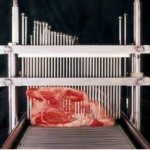
Agencies review mechanically tenderized meat
By Food in Canada magazine staff
Business Operations Food Safety Regulation Research & Development Meat &Poultry beef Health Canada meatHealth Canada and the Public Health Agency of Canada are reviewing how to handle and cook mechanically tenderized meat to help keep consumers safe
Ottawa – Health Canada and the Public Health Agency of Canada are reviewing mechanically tenderized meat products in order to better inform consumers on how to handle and cook them.
Health Canada and the agency announced in October that they will review the science around the safe handling and cooking of beef products that are mechanically tenderized.
The aim is to identify what information consumers and the food industry need in order to be safe.
Common practice
The practice of mechanically tenderizing meat is common and is used by suppliers, retailers and restaurants to improve the tenderness and flavour of cooked beef.
Costco stores in Alberta used the process, which might be the reason why some people fell ill. The meat that was used was from the Brooks, Alta.-plant belonging to XL Foods Inc. – the plant at the centre of Canada’s largest beef recall. Health officials in Alberta have ordered Costco stores to stop using the process.
How to be safe until review is complete
While the review of the process is underway and to make sure that any bacteria that may be present in the meat are killed, Health Canada and the Public Health Agency of Canada are encouraging Canadians to:
• cook mechanically tenderized steak and beef cuts to an internal temperature of at least 71 degrees Celsius (160 degrees Fahrenheit).
Reaching 71 degrees Celsius would cook steaks or roasts to approximately medium doneness, although a digital food thermometer should be used to be sure that the safe internal temperature is reached.
In addition to this advice, they continue to recommend that Canadians take steps to protect against the risks of food-borne illness, including E. coli.
These steps include:
• Wash hands before and cooking;
• Keep knives, counters and cutting boards clean;
• Keep raw meats separate from other foods when you store them; and
• Refrigerate or freeze left-overs promptly.
 Why mechanically tenderized meat poses a risk
Why mechanically tenderized meat poses a risk
In general, the internal temperature of a steak or other solid cut of meat is not a significant health concern given that any harmful bacteria that may be present would normally only be on the surface of the meat and would be eliminated even if cooked rare.
However, when steaks and beef cuts are mechanically tenderized, there is a potential for bacteria on the surface to be pushed into the centre of the meat.
As a result, there may be an increased chance that bacteria like E. coli O157:H7 are not fully eliminated when these beef products are cooked rare.
What the review entails
Health Canada’s review will look at the likelihood that the tenderizing process can spread bacteria, along with additional steps and best practices that can be applied by industry to prevent the spread of bacteria before a product reaches Canadian consumers.
The review will also evaluate the effectiveness of measures a consumer can take, including whether an internal temperature lower than 71 degrees Celsius (160 degrees Fahrenheit) would be as effective at reducing the risk from these products.
Health Canada is also working with the retail and food industry to support its efforts to identify mechanically tenderized beef for consumers through labels, signage or other means.
The industry expects to start putting these measures in place over the next two to three weeks.
Print this page